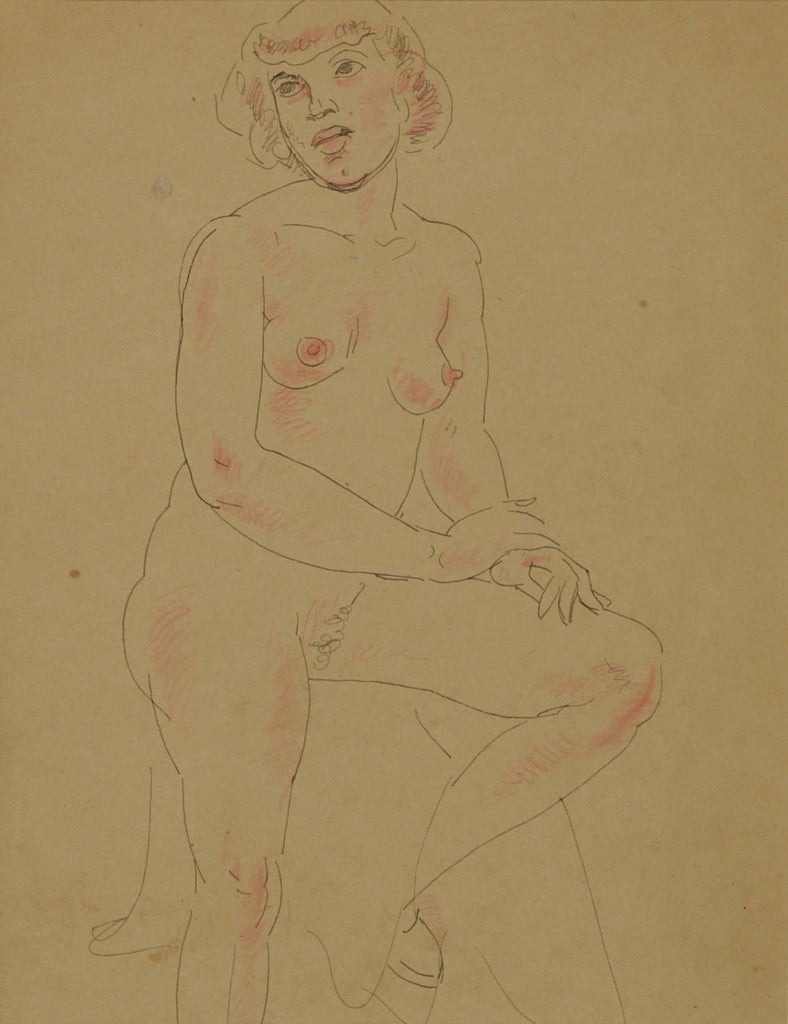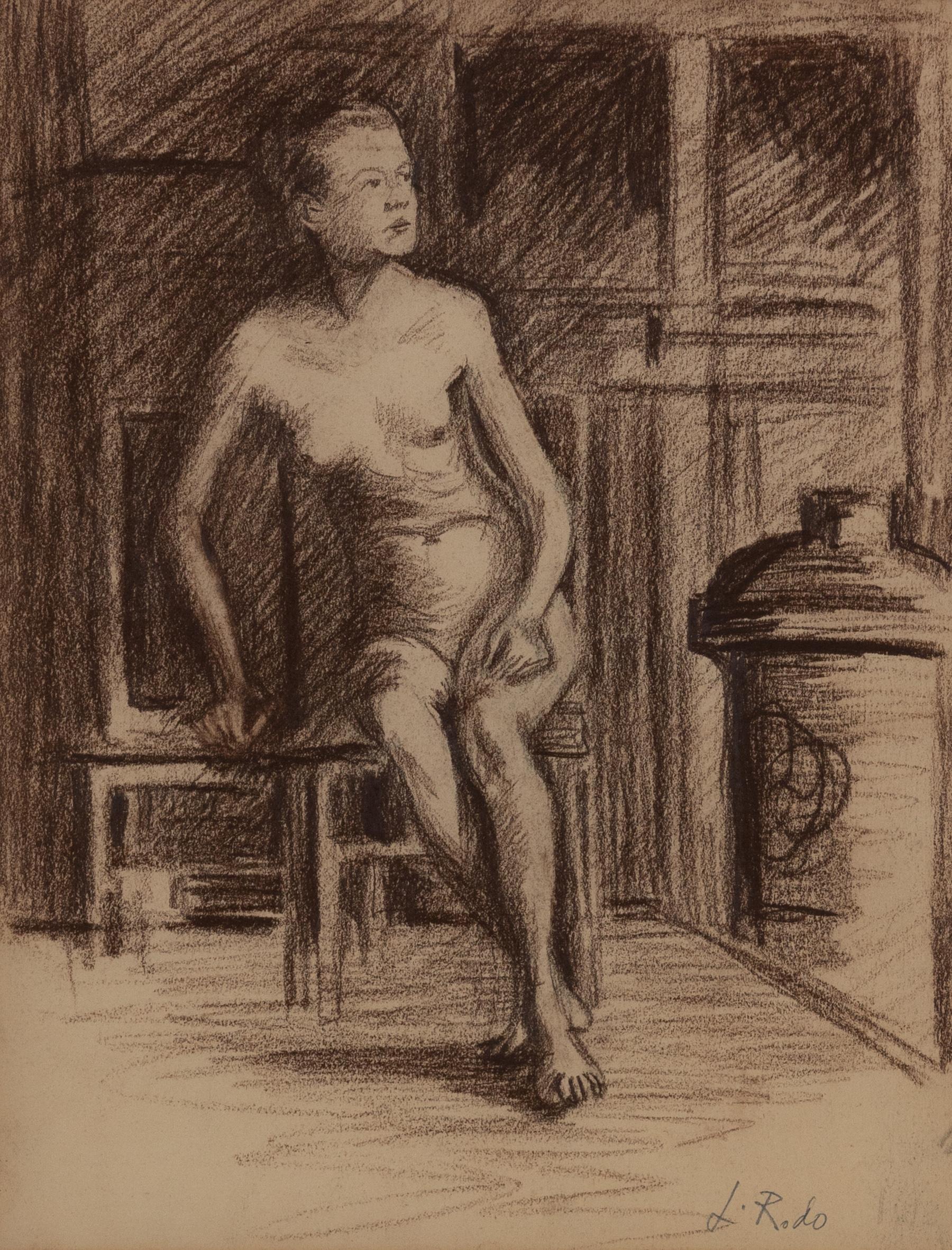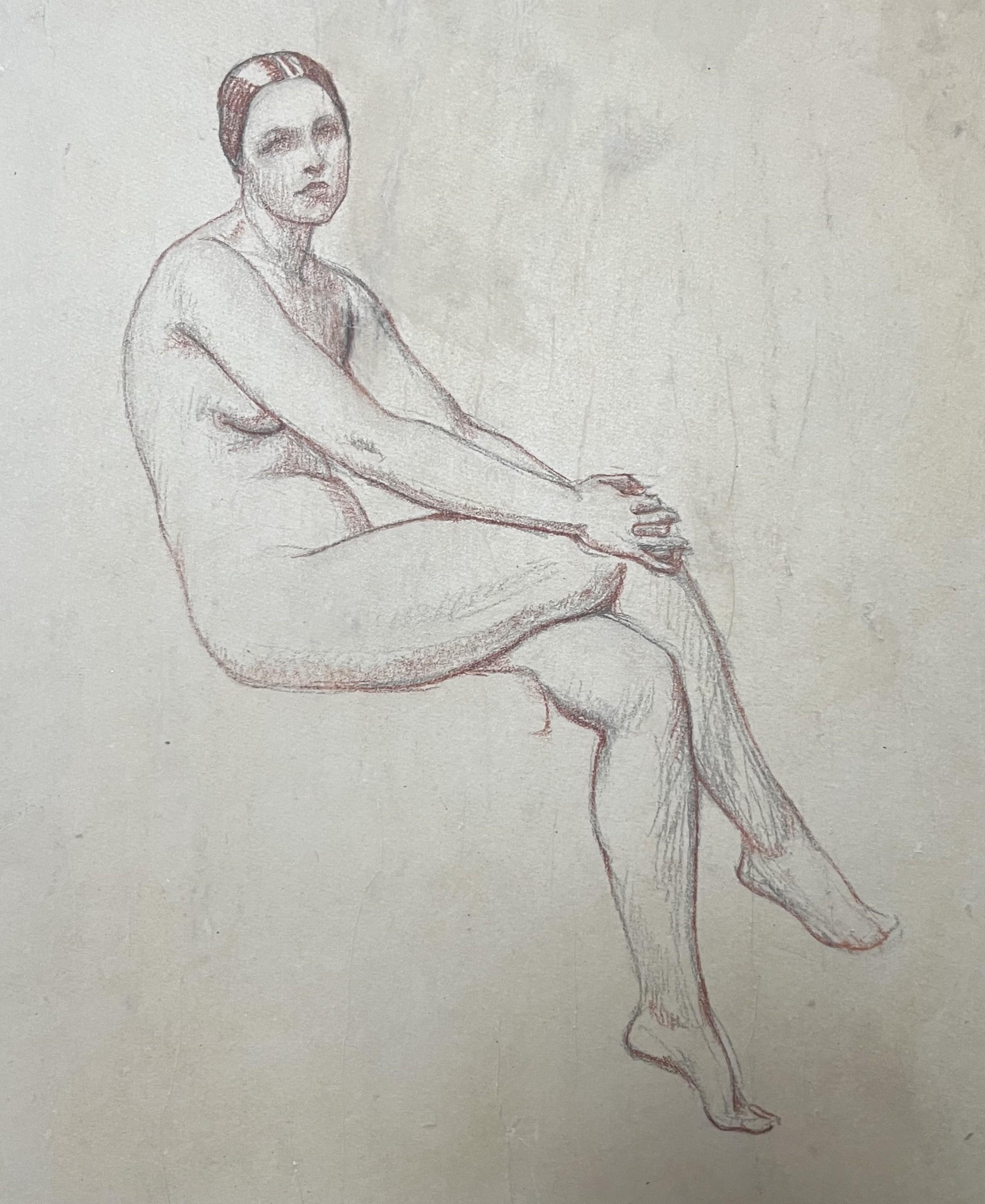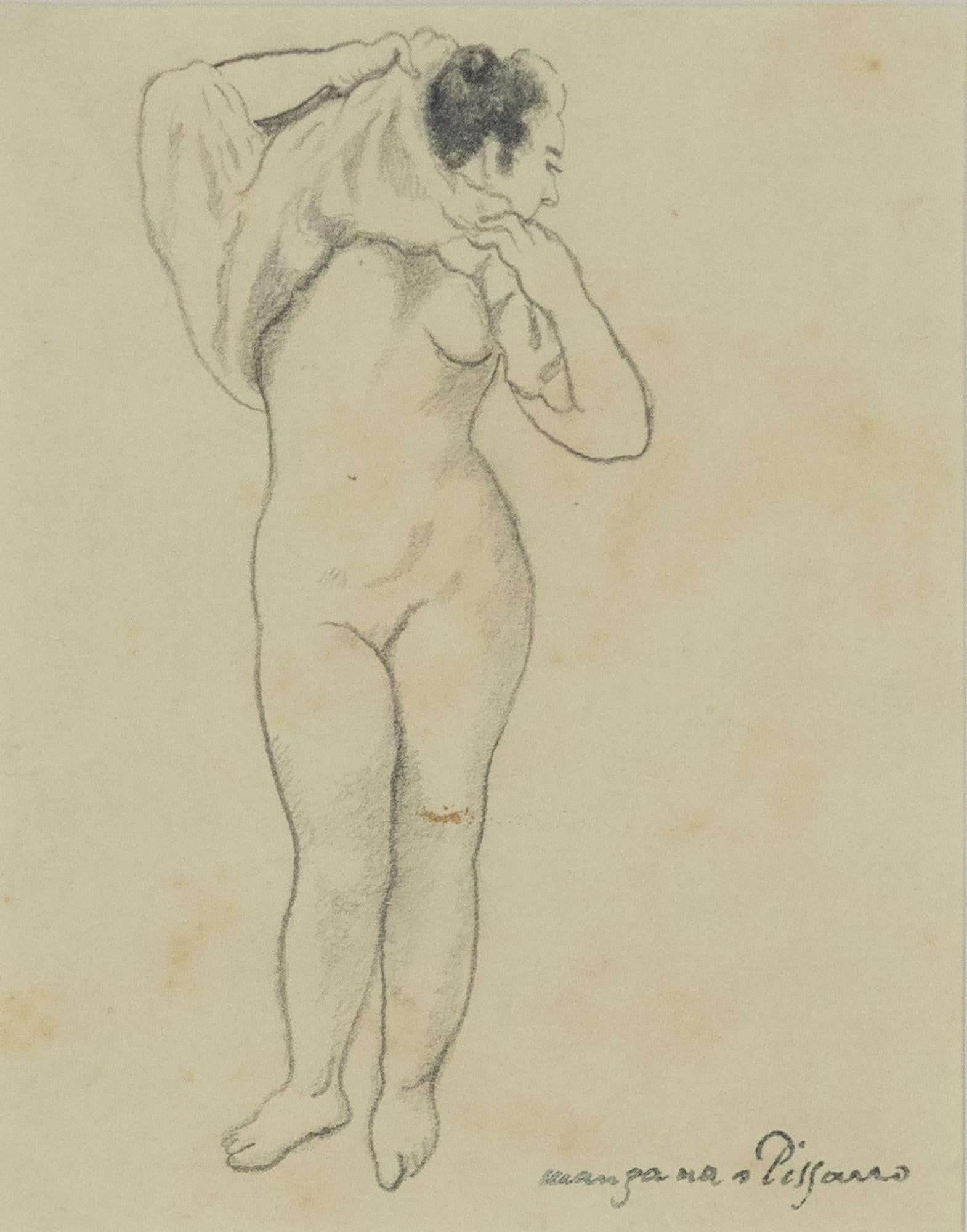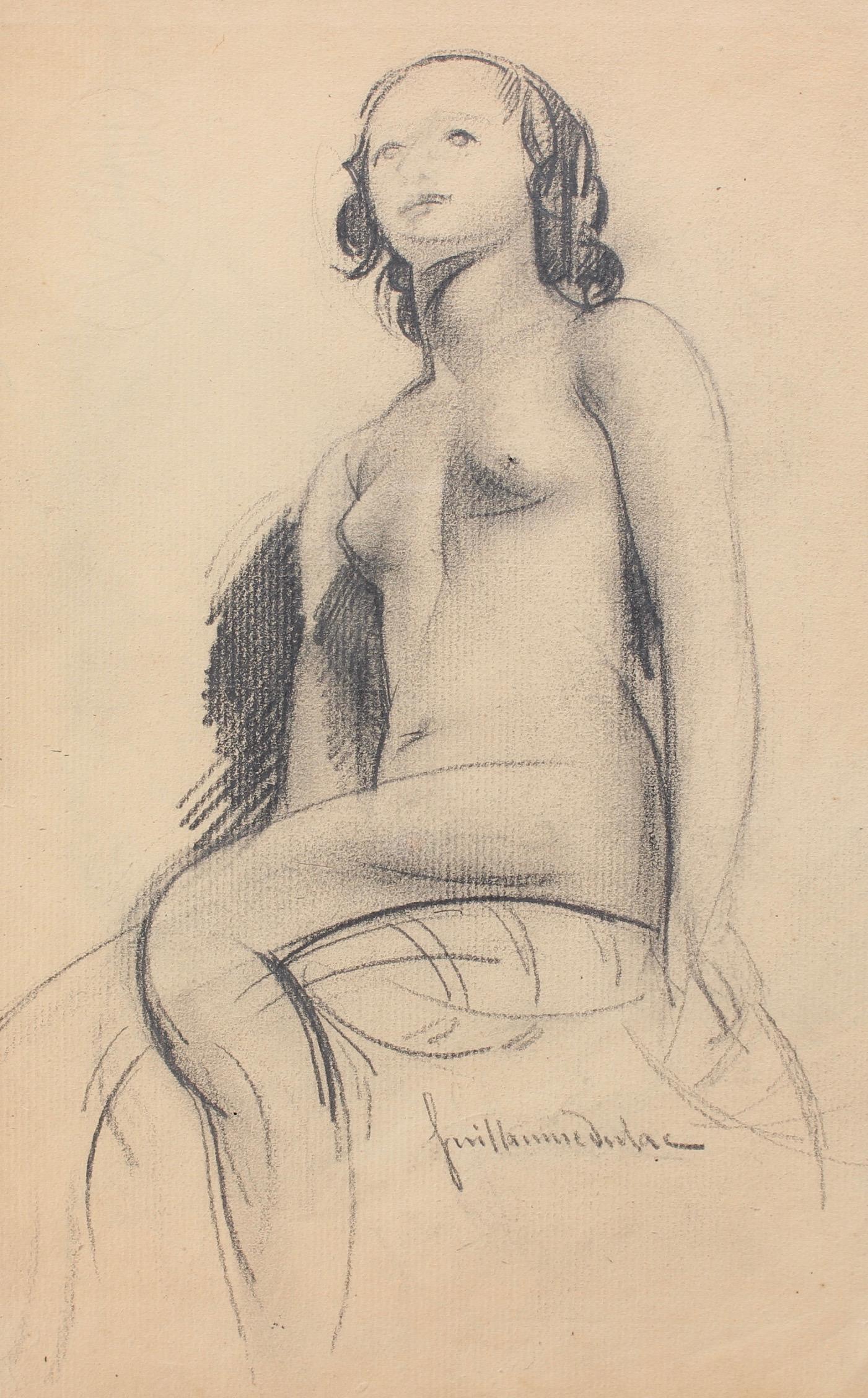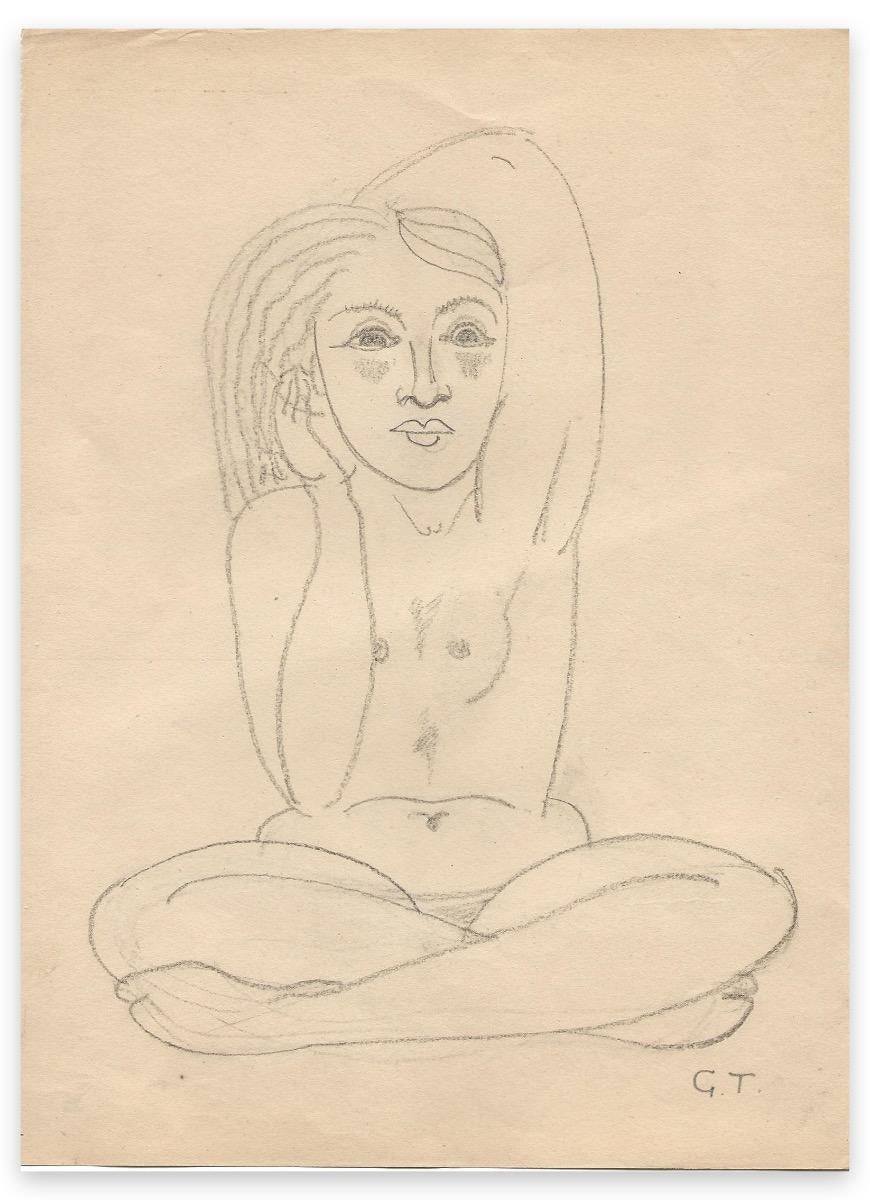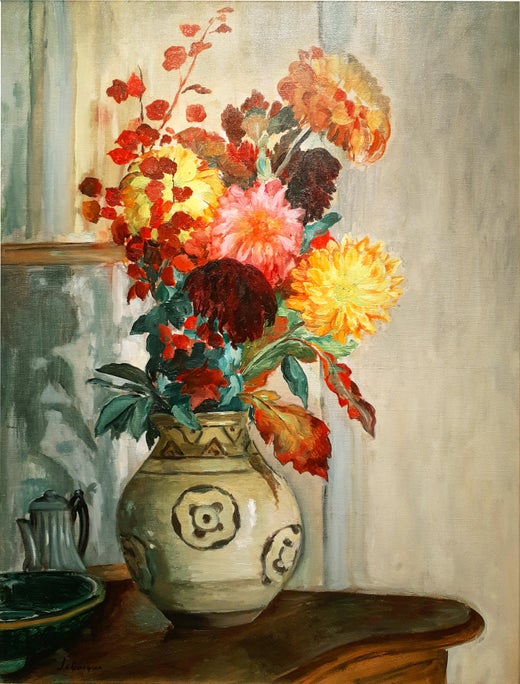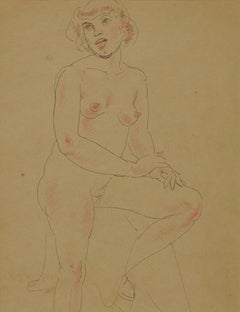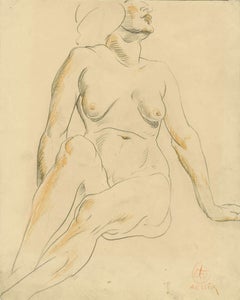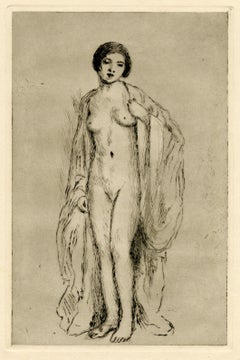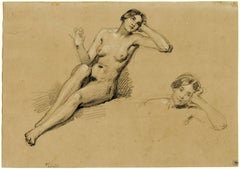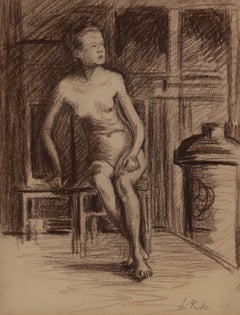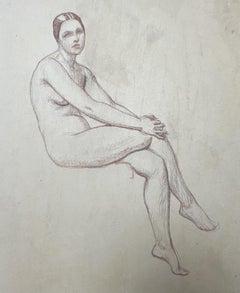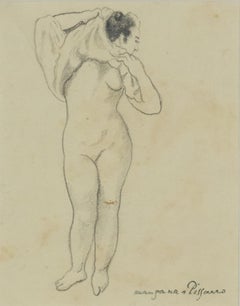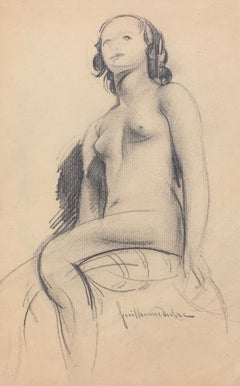Items Similar to Femme assise nue avec un bras levé au-dessus de sa tête Seated female nude ...
Want more images or videos?
Request additional images or videos from the seller
1 of 10
Henri LebasqueFemme assise nue avec un bras levé au-dessus de sa tête Seated female nude ...n.d.
n.d.
$4,500
£3,416.96
€3,907.55
CA$6,287.15
A$6,992.69
CHF 3,651.36
MX$85,093.55
NOK 46,633.48
SEK 43,733.98
DKK 29,163.51
Shipping
Retrieving quote...The 1stDibs Promise:
Authenticity Guarantee,
Money-Back Guarantee,
24-Hour Cancellation
About the Item
Femme assise nue avec un bras levé au-dessus de sa tête
Seated female nude with an arm raised over her head
Ink and watercolor on paper, n.d.
Signed in pencil lower right (see photo)
Condition: Excellent
Image size (Sight): 18 1/2 x 12 1/2 inches
Frame size: 30 1/2 x 24 inches
Provenance: Noted Private Collection, Beverly Hills, CA
"Henri Lebasque Biography
Dubbed “the painter of joy and light,” Henri Lebasque vibrantly evoked the sun-dappled landscapes and plush interiors of the French Riviera. A transitional figure between the Impressionists and the Fauves, his lively compositions show an attentiveness to the subtle shifts and diffusions of natural light as well as a readiness to inject purely expressive hues and gestures to a boldly emotive affect.
Henri Lebasque was born on September 25, 1865 in Champigné, Maine-et-Loire, France. At the age of 20, he went to Paris to study under the masterful academician Léon Bonnat. He soon befriended the seminal Impressionists Camille Pissarro and Auguste Renoir, as well as Édouard Vuillard and Pierre Bonnard, the founders of Les Nabis. In 1903, Lebasque became a founding member of the Salon d’Autumne, exhibiting alongside Henri Matisse, Albert Gleizes and Jacques Villon. Two years later, the Salon hosted the inaugural exhibition of the Fauves, whose ferocity of color and painterly exuberance exerted a strong effect on Lebasque’s mature work. Equally influential to Lebasque’s brightening palette was his move to the French Rivera, where he captured sunset sails, windswept bathers, young women reclining in hammocks by the shade of palm trees and other scenes of summery luxury. Lebasque died at Le Cannet, Alpes-Maritimes on August 7, 1937. Twenty years later, a major retrospective exhibition was organized at the Musée des Ponchettes in Nice.
Today, Lebasque's works can be found in numerous public institutions around the world, including the Thyssen-Bornemisza Museum in Spain, the National Museum of Western Art in Japan and the Harvard University Art Museum."
Courtesy of Sotheby's
- Creator:Henri Lebasque (1865-1937, French)
- Creation Year:n.d.
- Dimensions:Height: 18.5 in (46.99 cm)Width: 12.5 in (31.75 cm)
- Medium:
- Movement & Style:
- Period:
- Condition:
- Gallery Location:Fairlawn, OH
- Reference Number:Seller: FA122041stDibs: LU14014346042
Henri Lebasque
Henri Lebasque (25 September 1865 – 7 August 1937) was a French post-impressionist painter. He was born at Champigné (Maine-et-Loire). Lebasque was a founding member of the Salon d'Automne in 1903 with his friend Henri Matisse. Two years later, a group of artists exhibited there including Georges Rouault, André Derain, Édouard Vuillard, and Matisse. Lebasque also became friends with artists such as Gustave Rouault, Raoul Dufy, Louis Valtat, and Henri Manguin, the last of whom introduced Lebasque to the South of France. His time in South of France would lead to a radical transformation in Lebasque’s paintings, changing his colour palette forever. Other travels included the Vendée, Normandy, and Brittany. His work is represented in French museums, notably Angers, Geneva (Petit Palais), Lille (Musée des Beaux-Arts), Nantes, and Paris (Musée d’Orsay). Lebasque died at Cannet, Alpes Maritimes in 1937.
About the Seller
5.0
Recognized Seller
These prestigious sellers are industry leaders and represent the highest echelon for item quality and design.
Gold Seller
Premium sellers maintaining a 4.3+ rating and 24-hour response times
Established in 1978
1stDibs seller since 2013
799 sales on 1stDibs
Typical response time: <1 hour
Associations
International Fine Print Dealers Association
- ShippingRetrieving quote...Shipping from: Fairlawn, OH
- Return Policy
Authenticity Guarantee
In the unlikely event there’s an issue with an item’s authenticity, contact us within 1 year for a full refund. DetailsMoney-Back Guarantee
If your item is not as described, is damaged in transit, or does not arrive, contact us within 7 days for a full refund. Details24-Hour Cancellation
You have a 24-hour grace period in which to reconsider your purchase, with no questions asked.Vetted Professional Sellers
Our world-class sellers must adhere to strict standards for service and quality, maintaining the integrity of our listings.Price-Match Guarantee
If you find that a seller listed the same item for a lower price elsewhere, we’ll match it.Trusted Global Delivery
Our best-in-class carrier network provides specialized shipping options worldwide, including custom delivery.More From This Seller
View AllUntitled Nude (Double sided ink drawing with colored chalk)
By Henri Lebasque
Located in Fairlawn, OH
Female Nude (Double-sided drawing)
Recto: Reclining Nude
Verso: Seated Nude
Signed in pencil lower right, recto (see photo)
Pen and ink with colored chalk, c. 1925
Condition: Repaire...
Category
1920s French School Drawings and Watercolor Paintings
Materials
Ink
Untitled (seated female nude)
By Henry Keller
Located in Fairlawn, OH
Seated Femake Nude
Graphite and chalk on tan paper, c. 1920
Signed "Keller" and signed again with the artist's initials in a cypher
A finished life drawing most probably exhibited at...
Category
1920s American Modern Nude Drawings and Watercolors
Materials
Graphite
Standing Female Nude
By Frederick Carl Frieseke
Located in Fairlawn, OH
Standing Female Nude
Drypoint, c. 1910
Unsigned
Estate authentication on verso (see photo)
Estate authentication verso by Frances Frieseke Kilmer (Mrs. Kenton Kilmer, 1914-1998) (see photo)
Probably depicts the artist's wife, the artist's favorite model
Extremely rare original drypoint by Frieseke
Printed with selective inking to highlight the figure
Condition: excellent
Image/Plate size: 10 x 6 5/8 inches
Frame size: 19 1/4 x 15 3/4 inches
Provenance: Estate of the Artist
By descent to his daughter Frances
Hirschl & Adler Gallery, Stock No. APG 1106.3D-B (see photo)
Biography
Frederick Carl Frieseke was born on April 7, 1874, in Owosso, Michigan. After studying for a short while at the Art Institute of Chicago and the Art Students League in New York, Frieseke left for France in 1898, and almost all of his career was spent as an expatriate, with ties to the United States maintained through his New York dealer, William MacBeth, and by occasional visits to America. Following the pattern of innumerable young Americans, he enrolled at the Academie Julian where he studied with Benjamin Constant (1845-1902) and Jean-Paul Laurens (1838-1921). He appears to have had at least brief contact with and to have been influenced by James McNeill Whistler, who had recently opened his Academie Carmen in Paris.
By 1900 Frieseke was spending summers in the town of Giverny, made famous by the residence of Monet and subsequently by other artists, among them many Americans. In 1906, the year after his marriage to Sarah O'Bryan, he leased a house once occupied by the American Impressionist Theodore Robinson. Although the property was adjacent to Monet's, Frieseke had only limited contact with the French master. Instead he apparently found Pierre Auguste Renoir the most influential of all the Impressionists. Frieseke's Giverny house and garden, as settings for a series of female models, provided nearly all of his subject matter for the next thirty years, although in 1930 he made a series of watercolors of Florida scenes remembered from his childhood and painted some Swiss landscapes. After World War I, the artist and his family settled in Normandy.
Frieseke's career falls roughly into three stages. In the first, figures most clearly show his academic training and draughtsmanship. Gradually these evolve into the most common images of the next decade, comprised of loosely-applied blotches of bright color. The vast majority of these show their subjects in the garden, standing among the flowers, taking tea, or just basking in the sun. Others include models in colorful, light-filled interiors. In Frieseke's latest paintings, the figures very often appear indoors, their forms are given greater solidity, and the brushwork is less broken.
At the height of his career, in the 1910s and early 1920s, Frieseke was perhaps the most popular of all living American artists. He received numerous awards and medals and saw his work purchased by private collectors and major museums. Decades after the initial introduction of Impressionism by Monet and his contemporaries, Frieseke assumed this style for his work, choosing to ignore the newer artistic movements of the early twentieth century. Nevertheless, his paintings were acclaimed in both the United States and in Europe. In 1904 he won a silver medal at the St. Louis Universal Exposition and a gold medal at Munich. He was elected a member of the Société National des Beaux Arts in 1908 and the National Academy of Design in 1912. Seventeen of his canvases were featured at the Venice Biennale in 1909 and he won the Grand Prize at the Panama-Pacific International Exposition in 1915. He was commissioned to execute several murals, including one for the New York store of John Wanamaker, one of his most loyal patrons.
He died on August 28, 1939, at his home in Normandy, in the town of Le Mesnil sur Blangy. In the decades following his death, however, after artistic tastes had changed considerably, his work was nearly forgotten until it received renewed attention as interest in American Impressionism grew in the 1960s Courtesy National Gallery of Art, Washington
Etchings by Frederick Carl Frieseke include The Balcony and Standing Female Nude. Frieseke was an American Impressionist painter who was popular in the 1910s and 1920s.
Etchings by Frederick Carl Frieseke:
The Balcony: An etching by Frieseke from 1904
Standing Female Nude
Other paintings by Frederick Carl Frieseke:
The Garden Parasol...
Category
1910s American Impressionist Nude Prints
Materials
Drypoint
Seated Female Nude (two studies)
By Pierre Saint-Ange Poterlet
Located in Fairlawn, OH
Recling Female Nude
Charcoal on tan paper
Signed: Poterlet bottom center (see photo)
Provenance:
Alfred Barrion, Lugt 76 lower right recto (see photo)
Eric G. Carlson, 1985
Very good...
Category
19th Century Romantic Nude Drawings and Watercolors
Materials
Charcoal
Nude Woman in Chair
By William Sommer
Located in Fairlawn, OH
Nude Woman in Chair
Watercolor, gouache, ink, and pencil on heavy paper, c. 1930-35
Signed with the artist's Estate stamp lower right (see photo)
Note: "Matchstick" ink drawing of fe...
Category
1930s American Modern Nude Drawings and Watercolors
Materials
Watercolor
Side View Seated Female Nude
By Frank Duveneck
Located in Fairlawn, OH
Side View Seated Female Nude
Graphite on paper, c. 1890's
Unsigned
Provenance:
Rookwood Pottery Factory Collection, Cincinnati
Spanierman Gallery, New York (label)
Drawings from the...
Category
1890s American Impressionist Nude Drawings and Watercolors
Materials
Graphite
You May Also Like
Nu Assise by Ludovic-Rodo Pissarro - Nude drawing
By Ludovic-Rodo Pissarro
Located in London, GB
Nu Assise by Ludovic-Rodo Pissarro (1878-1952)
Charcoal on paper
31.3 x 24.2 cm (12 ⅜ x 9 ½ inches)
Signed lower right, L.Rodo
This work of art is accompanied by a certificate of authenticity signed and dated by Lélia Pissarro.
Artist biography:
Ludovic-Rodolphe Pissarro, born in Paris in 1878, was Camille Pissarro’s fourth son. Encouraged by his father, he began drawing from nature at an early age. He was familiarly known as “Rodo” and generally signed his works "Ludovic-Rodo", or early on in his career simply "Rodo".
The impact of Camille’s art and teaching on Rodo was considerable. His artistic production encompassed a wide range of media, including oil painting, tempera, watercolour, gouache, wood engraving, drawing and lithography. Rodo exhibited regularly at the Salon des Indépendants over a forty-year period.
In 1894, at the age of sixteen, Rodo published his first wood engravings in the anarchist journal, Le Père Peinard. When Camille left France for the safety of Belgium during the anarchist upheavals of the same year, Rodo joined him there.
Rodo moved into his first studio in Montmartre with his brother Georges in 1898. Works of this early important period until just after the death of his father in 1903 were post-impressionist and clearly painted under the influence of his father.
By 1904 living in Paris, he found the nightlife and the habitués of the cafes, theatres, circuses and cabarets compelling subjects for his work and changed dramatically the style of his painting, affiliating himself to the Fauve artists. Rodo became close to artists such as Kees Van Dongen, Maurice de Vlaminck and Raoul Dufy. In 1905 he participated in the first Fauve exhibition at the Salon des Indépendants. In 1907 he visited Van Dongen in Rotterdam and the two artists continued to paint together, something they often did in Paris.
In 1914 he married, though he never had children. Later that year at the outbreak of the War Rodo moved to England. Over the next seven years he lived mainly in and around West London. He worked closely with his brother Lucien to establish in 1915 the Monarro Group, formed with the aim of exhibiting work by contemporary artists inspired by Impressionism. Many of the works produced by Rodo while he was in England were of London landmarks but, he was also interested in the urbanisation of West London. After 1921, when Rodo had already returned to France, he divided his time between Paris and Les Andelys in Normandy, living and working closely with his elder brother Georges Manzana.
Despite his rich artistic heritage and his achievements as an artist, Rodo is perhaps best remembered for his contribution to art history. For ten years he researched and compiled a catalogue of his father’s paintings...
Category
Early 1900s Post-Impressionist Figurative Drawings and Watercolors
Materials
Paper, Charcoal
Octave Denis Victor Guillonnet (1872 - 1967) A naked woman seated, drawing
By Octave Guillonnet
Located in Paris, FR
Octave Denis Victor Guillonnet (1872 - 1967)
A naked young woman seated
Charcoal and red chalk on thin paper transfered on cardboard
49 x 39 cm
Framed : 55.5 x 45.5 cm
Octave Denis...
Category
1930s Art Deco Portrait Drawings and Watercolors
Materials
Chalk, Charcoal
Undressing by Georges Manzana Pissarro - Nude drawing
By Georges Henri Manzana Pissarro
Located in London, GB
Undressing by Georges Manzana Pissarro (1871-1961)
Pencil on paper
13.6 x 10.6 cm (5 ³/₈ x 4 ¹/₈ inches)
Signed with Estate stamp lower right, manzana- Pissarro
This work is accompa...
Category
20th Century Post-Impressionist Figurative Drawings and Watercolors
Materials
Paper, Pencil
The Seated Nude
By Guillaume Dulac
Located in London, GB
'The Seated Nude', pencil on fine art paper, by French artist, Guillaume Dulac (circa 1920s). An artist known for his exquisite drawings - many are sketches for his larger oil painti...
Category
1920s Nude Drawings and Watercolors
Materials
Paper, Pencil
$602 Sale Price
20% Off
Seated Naked Woman - Drawing by George-Henri Tribout - Early 20th Century
By Georges-Henri Tribout
Located in Roma, IT
Naked Woman Seated Legs Folded and Arms Behind is an original artwork realized by George Henri Tribout.
Original pencil drawing on paper.
Signed G.T.
This interesting drawing show...
Category
Early 20th Century Modern Figurative Drawings and Watercolors
Materials
Paper, Pencil
Nu Assise by Ludovic-Rodo Pissarro - Nude painting
By Ludovic-Rodo Pissarro
Located in London, GB
Nu Assise by Ludovic-Rodo Pissarro (1878-1952)
Oil on canvas
55 x 47 cm (21 ⅝ x 18 ½ inches)
Signed lower left, Ludovic Rodo
Executed circa 1910
This work is accompanied by a cer...
Category
1910s Fauvist Nude Paintings
Materials
Canvas, Oil
More Ways To Browse
Female Nude French Painting
Impressionist Female Nude
Pierre Bonnard Drawing
Art De France Shade
Renoir Drawings
Female Reclining Nudes
Palm Tree Drawing
Nude Bather
Art Bra
Used Hammock
Reclining Nude Pencil
Nude Bather Painting
Dior Riviera
Japanese Palm Trees
Japanese Seated Figure
Leon Bonnat
Henri Matisse Nice
Tete De Femme
